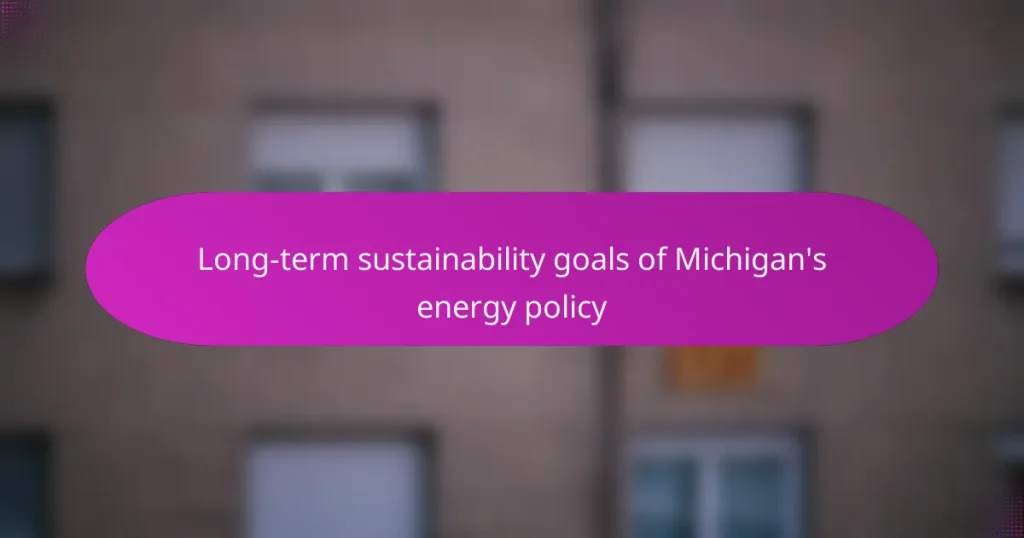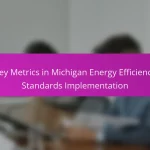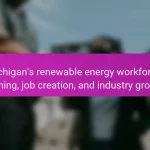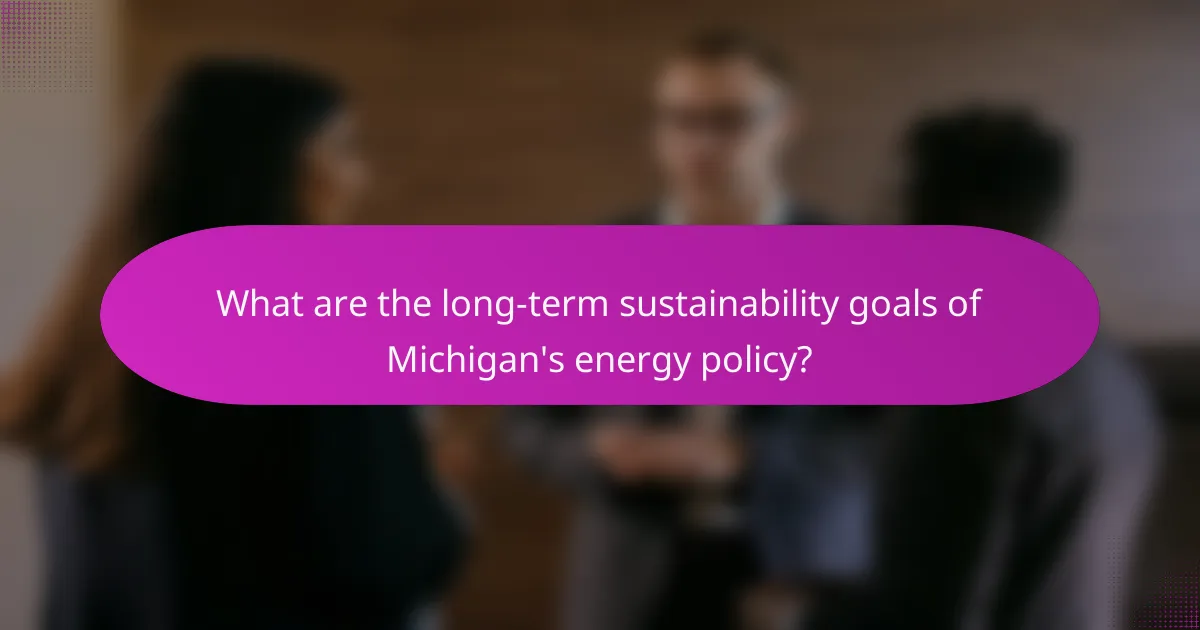
What are the long-term sustainability goals of Michigan’s energy policy?
Michigan’s energy policy aims for long-term sustainability through several key goals. These include increasing renewable energy generation to 50% by 2030. The state also targets a 26% reduction in greenhouse gas emissions by 2025. Another goal is to improve energy efficiency in buildings by 20% by 2025. Michigan plans to phase out coal-fired power plants, emphasizing cleaner energy sources. The policy promotes investment in electric vehicle infrastructure and encourages sustainable transportation options. These goals align with national efforts to combat climate change and promote energy independence.
How do these goals align with national sustainability efforts?
Michigan’s long-term sustainability goals align with national sustainability efforts by promoting clean energy and reducing greenhouse gas emissions. These goals support the U.S. commitment to the Paris Agreement, aiming to limit global warming. Michigan targets a 50% reduction in carbon emissions by 2030, aligning with national objectives. The state also emphasizes renewable energy, aiming for 50% of its energy from renewable sources by 2030. This mirrors the national push for a transition to clean energy. Additionally, Michigan’s energy efficiency initiatives contribute to national energy conservation goals. Overall, Michigan’s policies reflect a commitment to sustainable development in harmony with national strategies.
What specific targets has Michigan set for renewable energy adoption?
Michigan has set a target to achieve 50% renewable energy by 2030. This goal is part of the state’s broader commitment to reduce carbon emissions. Additionally, Michigan aims for a 100% carbon-free energy supply by 2040. These targets are outlined in the state’s Clean and Renewable Energy Plan. The plan emphasizes the transition to wind, solar, and other renewable sources. This strategy aligns with national trends toward sustainable energy practices. The targets are designed to promote environmental sustainability and economic growth.
How does Michigan’s energy policy address climate change?
Michigan’s energy policy addresses climate change through a commitment to reducing greenhouse gas emissions. The state aims to achieve a 28% reduction in emissions by 2025 from 2005 levels. This is part of a broader goal to transition to 100% carbon-free energy by 2040. The policy promotes renewable energy sources such as wind and solar. Michigan also emphasizes energy efficiency programs to reduce overall consumption. The state has set a target of 15% energy savings by 2021. Additionally, Michigan’s energy policy supports electric vehicle adoption to decrease reliance on fossil fuels. These measures collectively contribute to mitigating climate change impacts.
What are the key components of Michigan’s energy policy?
Michigan’s energy policy includes key components such as renewable energy standards, energy efficiency programs, and emissions reduction targets. The state aims for 50% of its electricity to come from renewable sources by 2030. Energy efficiency programs focus on reducing consumption and lowering costs for consumers. Additionally, Michigan has set a goal to reduce greenhouse gas emissions by 28% by 2025, based on 2005 levels. The policy also promotes the development of electric vehicle infrastructure to support cleaner transportation options. These components collectively work towards enhancing energy security and sustainability in Michigan.
What role do renewable energy sources play in Michigan’s strategy?
Renewable energy sources are central to Michigan’s energy strategy. They aim to reduce greenhouse gas emissions and promote sustainability. The state has set a goal of achieving 50% renewable energy by 2030. This includes investments in wind, solar, and hydroelectric power. Michigan’s strategy also focuses on enhancing energy efficiency. The transition to renewable sources is expected to create jobs in the clean energy sector. Furthermore, it aligns with national efforts to combat climate change. The state has established incentives to encourage renewable energy adoption. Overall, renewable energy is key to Michigan’s long-term sustainability goals.
How is energy efficiency promoted within Michigan’s policy framework?
Energy efficiency in Michigan’s policy framework is promoted through various legislative measures and programs. The state implements the Clean, Renewable, and Efficient Energy Act. This act establishes energy efficiency standards for utilities. It mandates utilities to achieve specific energy savings targets. Additionally, the Michigan Public Service Commission oversees utility compliance with these standards. The commission also facilitates energy efficiency programs for residential and commercial sectors. Incentives are provided for energy-efficient technologies and practices. Furthermore, the state collaborates with local governments and organizations to enhance energy-saving initiatives. These combined efforts aim to reduce energy consumption and promote sustainable practices across Michigan.
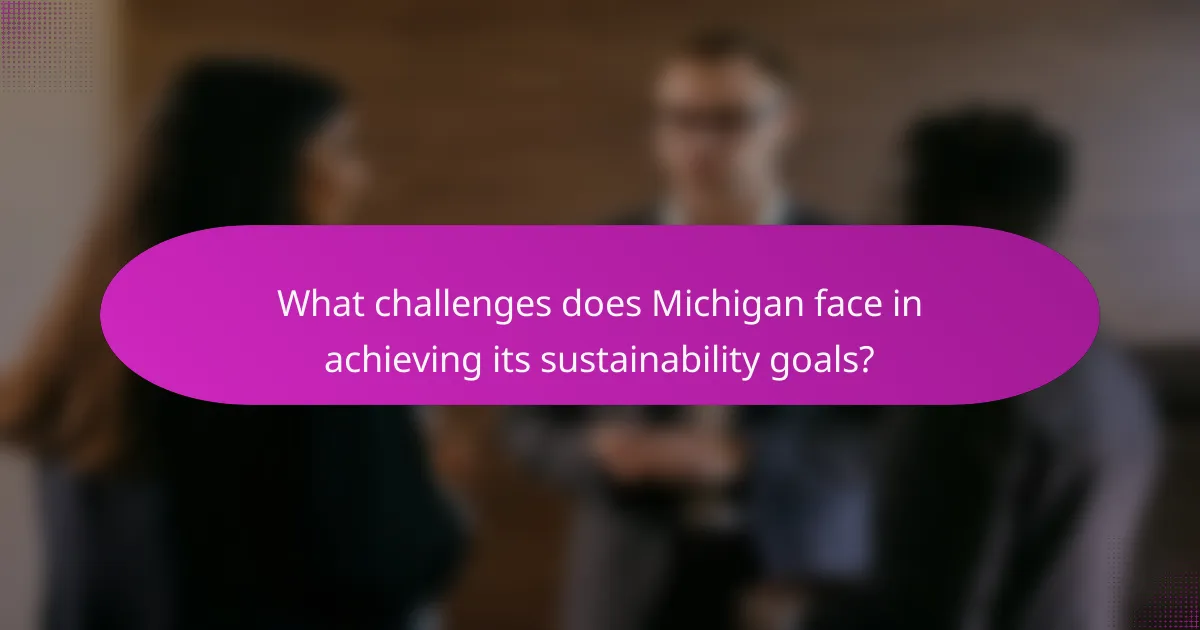
What challenges does Michigan face in achieving its sustainability goals?
Michigan faces several challenges in achieving its sustainability goals. One significant challenge is funding limitations for renewable energy projects. The state has set ambitious targets for reducing greenhouse gas emissions, but securing the necessary investments remains difficult. Regulatory barriers also hinder progress, as outdated policies can slow the adoption of clean technologies. Additionally, infrastructure constraints pose a problem, particularly in integrating renewable energy sources into the existing grid. Public awareness and engagement are also lacking, which can affect support for sustainability initiatives. Finally, climate change impacts, such as extreme weather events, can disrupt efforts to implement sustainable practices effectively.
What are the economic implications of transitioning to sustainable energy?
Transitioning to sustainable energy has significant economic implications. It can lead to job creation in renewable energy sectors. The U.S. solar and wind industries employed over 250,000 workers in 2020. Investment in sustainable energy can stimulate local economies. For instance, Michigan’s clean energy sector is projected to grow, attracting investments. Additionally, transitioning reduces dependency on fossil fuels, leading to lower energy costs in the long run. A report by the International Renewable Energy Agency states that renewable energy technologies can provide cheaper energy solutions. Moreover, sustainable energy can enhance energy security, reducing vulnerability to price fluctuations. Overall, these factors contribute to a more resilient and sustainable economy.
How do job markets in Michigan adapt to changes in the energy sector?
Job markets in Michigan adapt to changes in the energy sector through workforce retraining and investment in renewable energy. As the state shifts towards cleaner energy sources, programs are established to reskill workers from traditional energy sectors. For instance, the Michigan Energy Workforce Development Program focuses on training for solar and wind energy jobs.
Additionally, partnerships between educational institutions and energy companies promote curriculum updates to meet industry demands. The Michigan Economic Development Corporation supports initiatives that encourage job creation in emerging energy fields. Reports indicate that renewable energy jobs in Michigan grew by over 20% from 2017 to 2019.
This transition aligns with Michigan’s long-term sustainability goals, aiming for a 50% reduction in greenhouse gas emissions by 2030. Overall, the job market’s adaptability is evident through targeted training programs and state-supported initiatives that respond to the evolving energy landscape.
What financial barriers exist for implementing sustainable energy solutions?
High upfront costs are a significant financial barrier to implementing sustainable energy solutions. Many renewable energy technologies require substantial initial investments. For example, solar panel installations can range from $15,000 to $30,000 for residential systems. This cost can deter individuals and businesses from adopting these solutions. Additionally, financing options may be limited or come with high-interest rates. Many consumers lack access to affordable loans or incentives that can ease the financial burden. Long payback periods further discourage investment in sustainable energy. According to the U.S. Department of Energy, the average payback period for solar energy systems can be 5 to 10 years. This timeframe may not align with the financial goals of many potential investors. Overall, these factors create a challenging financial landscape for sustainable energy implementation.
How does public perception impact Michigan’s energy policy?
Public perception significantly influences Michigan’s energy policy. Policymakers often consider public opinion when developing energy initiatives. High public support for renewable energy leads to increased investment in sustainable technologies. Conversely, negative perceptions can hinder policy advancements. Surveys show that a majority of Michiganders favor clean energy solutions. This support drives legislative changes and funding allocations. Public advocacy groups also play a role in shaping energy discourse. Their campaigns can raise awareness and prompt governmental action on sustainability issues.
What strategies are used to engage the public in sustainability initiatives?
Public engagement in sustainability initiatives often involves education, community involvement, and incentives. Educational programs raise awareness about sustainability issues. Workshops and seminars help people understand their impact on the environment. Community involvement encourages local participation in sustainability projects. This can include tree planting, recycling drives, or clean-up events. Incentives, such as tax breaks or grants, motivate individuals and businesses to adopt sustainable practices. Research shows that communities with active engagement see higher participation rates in sustainability efforts. For example, the Michigan Department of Environment, Great Lakes, and Energy promotes public engagement through various initiatives.
How do stakeholder opinions shape policy decisions?
Stakeholder opinions significantly influence policy decisions. Policymakers often consider feedback from stakeholders to align policies with public interests. This engagement fosters transparency and trust in the decision-making process. For example, in Michigan’s energy policy, stakeholders include local communities, environmental groups, and businesses. Their input can lead to adjustments in policy proposals to better address sustainability goals. Research shows that policies reflecting stakeholder concerns are more likely to gain public support. According to a study by the Michigan Public Service Commission, incorporating stakeholder feedback improved the effectiveness of energy initiatives. Thus, stakeholder opinions are vital in shaping effective and sustainable policy decisions.

What future trends are expected in Michigan’s energy policy?
Future trends in Michigan’s energy policy include a significant shift towards renewable energy sources. The state aims to achieve 50% renewable energy by 2030. This goal is part of a broader initiative to reduce greenhouse gas emissions. Additionally, Michigan is focusing on energy efficiency improvements across various sectors. Investments in electric vehicle infrastructure are also expected to increase. The state plans to enhance grid reliability and resilience. Furthermore, community solar projects are gaining traction to promote local energy generation. These trends reflect Michigan’s commitment to long-term sustainability goals.
How might technological advancements influence sustainability goals?
Technological advancements can significantly influence sustainability goals by enhancing energy efficiency and reducing emissions. Innovations in renewable energy technologies, such as solar and wind, increase energy production while minimizing environmental impact. For instance, advancements in solar panel efficiency have led to a 90% reduction in costs over the last decade. Smart grid technologies improve energy distribution and management, allowing for better integration of renewable sources. Electric vehicles, driven by advancements in battery technology, reduce reliance on fossil fuels. According to the International Energy Agency, widespread adoption of electric vehicles could cut global CO2 emissions by 1.5 gigatons annually by 2030. Additionally, advancements in carbon capture and storage technologies can mitigate emissions from industrial processes. These technological innovations collectively support Michigan’s long-term sustainability goals by promoting cleaner energy solutions and reducing the carbon footprint.
What emerging technologies are being considered for energy production?
Emerging technologies being considered for energy production include advanced solar panels, offshore wind farms, and energy storage systems. Advanced solar panels utilize innovative materials to enhance efficiency and reduce costs. Offshore wind farms take advantage of stronger and more consistent winds found at sea. Energy storage systems, such as lithium-ion batteries, allow for better management of energy supply and demand. Additionally, hydrogen fuel cells are gaining attention for their potential to provide clean energy. These technologies align with Michigan’s long-term sustainability goals by promoting renewable energy sources and reducing greenhouse gas emissions.
How can smart grid technology enhance energy efficiency?
Smart grid technology enhances energy efficiency by optimizing electricity distribution and consumption. It allows for real-time monitoring of energy use. This technology enables automated demand response, adjusting power usage during peak times. Smart grids integrate renewable energy sources more effectively. They facilitate two-way communication between utilities and consumers. This interaction empowers consumers to manage their energy consumption better. According to the U.S. Department of Energy, smart grids can reduce energy consumption by up to 15%. This reduction leads to lower emissions and supports long-term sustainability goals.
What best practices can Michigan adopt to achieve its sustainability goals?
Michigan can adopt several best practices to achieve its sustainability goals. These practices include increasing renewable energy sources, such as wind and solar power. Transitioning to electric vehicles can also significantly reduce greenhouse gas emissions. Implementing energy efficiency programs in homes and businesses will lower energy consumption. Promoting sustainable agriculture practices can enhance food security and reduce environmental impact. Investing in public transportation can decrease reliance on personal vehicles. Establishing stricter building codes for energy efficiency will ensure new constructions meet sustainability standards. Engaging local communities in sustainability initiatives fosters public awareness and participation. Finally, collaborating with businesses to develop green technologies can drive innovation and economic growth.
How can collaboration with local communities improve energy initiatives?
Collaboration with local communities can significantly enhance energy initiatives. Engaging local stakeholders fosters trust and transparency. It allows for tailored energy solutions that meet specific community needs. Communities often provide valuable insights into local resources and challenges. This grassroots involvement can lead to higher participation rates in energy programs. Research shows that community-driven projects have higher success rates. For instance, the Michigan Energy Office emphasizes local engagement as a key strategy. Such collaboration can also promote education and awareness about energy efficiency. Ultimately, local partnerships create a more sustainable and effective energy landscape.
What role does education play in promoting sustainable energy practices?
Education plays a critical role in promoting sustainable energy practices. It equips individuals with the knowledge needed to understand energy systems. This understanding fosters awareness of energy conservation and renewable resources. Educational programs can increase public engagement in sustainability initiatives. In Michigan, educational institutions are integrating sustainability into their curricula. This approach prepares future leaders to advocate for sustainable policies. Research shows that informed citizens are more likely to adopt energy-efficient behaviors. For example, the Michigan Energy Efficiency Program highlights the impact of educational outreach on energy savings.
The main entity of this article is Michigan’s energy policy, specifically its long-term sustainability goals. The article outlines Michigan’s objectives to increase renewable energy generation to 50% by 2030, reduce greenhouse gas emissions by 26% by 2025, and improve energy efficiency in buildings by 20% by 2025. It discusses how these goals align with national sustainability efforts, the role of renewable energy sources, and the challenges faced in achieving these targets. Additionally, the article examines the economic implications of transitioning to sustainable energy, public perception, and future trends in Michigan’s energy policy.
